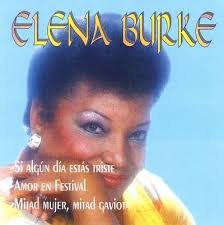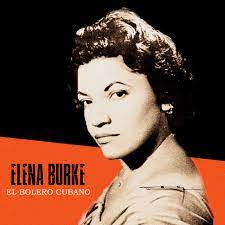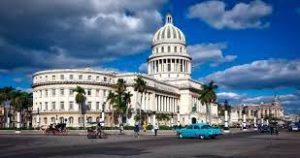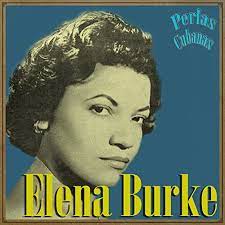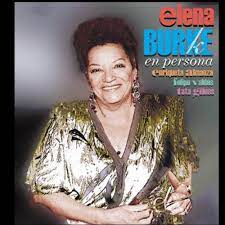ELENA BURKE “SEÑORA SENTIMIENTO”, ARTISTA EMBLEMÁTICA DE LA MÚSICA CUBANA. PHOTOS/VIDEOS
Elena Burke, fue una venerada y popular cantante cubana de boleros y baladas románticas nacida en la Habana un 28 de febrero de 1928.
Se destacó por su versatilidad y la manera muy personal de interpretar los temas. Integró el movimiento filin, realzándolo con su potente voz contralto que contrastaba con su agridulce entonación. Sus interpretaciones son fuente de estudio para las nuevas generaciones de artistas. Mujer de extraodinario carisma y sencillez. Artista emblemática de la música cubana.
CARRERA ARTISTICA
Su primer contacto con la música, fue a través del tango, particularmente “Caminito”, que cantó en 1940 en la radioemisora CMC. Su ídolo en esa etapa era la cantante argentina Libertad Lamarque. En 1943 se presentó en ‘La Corte Suprema del Arte’, de CMQ Radio, donde ganó premio en unión de Rosita Fornés y Miguel Ángel Ortiz. Ese mismo año comenzó a trabajar en la radioemisora Mil Diez, en el espacio Ensoñación, con una orquesta dirigida por Enrique González Mántici y Adolfo Guzmán. Recibió orientaciones de música de Isolina Carrillo, y trabajó con Dámaso Pérez Prado y Frank Fernández como pianistas acompañantes.
 VIDEOS- Elena Burke canta “Amame como Soy”..
VIDEOS- Elena Burke canta “Amame como Soy”..
Integró el Cuarteto de Orlando de la Rosa, junto a Aurelio Reinoso, Roberto Barceló y Adalberto del Río, con el que recorrió los Estados Unidos; su sede, en Nueva York, era ‘La Taberna Cubana’. Posteriormente fue miembro del Cuarteto de Facundo Rivero, con el que actuó durante varios años en cabarets de México, que le dio el entrenamiento escénico que después volcaría en el cuarteto D’Aida, creado por Aida Diestro Rega. Más tarde integró el trío Las Cancioneras, dirigido por la pianista Enriqueta Almanza.
En 1947 fue una de las fundadoras de ‘Las Mulatas de Fuego’, que debutaron en el teatro Fausto, y posteriormente se presentaron en el Alkázar y Encanto (con Josephine Baker) con Serenata mulata, y posteriormente presentaron Rapsodia en bronce y negro, bajo la dirección del pianista y compositor Felo Bergaza; luego viajaron a México, donde fueron contratadas por el Follies Bergère, actuaron junto a Yolanda Montes (Tongolele) y participaron en el filme Salón México, dirigido por el Indio Fernández. En 1952 fue una de las fundadoras del Cuarteto D’Aida debutaron en el programa Carrousel de las Sorpresas, de CMQ Televisión, con Omara y Haydée Portuondo y Moraima Secada, bajo la dirección de la pianista y repertorista Aida Diestro.
CONSAGRACIÓN DE ELENA BURKE EN LOS AÑOS 60s.
En la década del 60 fundó el grupo Los D’Ángeles, dirigido por Enriqueta Almanza. Representó a Cuba en el IV Festival de Málaga (España), y en el Festival Internacional de la Canción de Viña del Mar (Chile). En 1964 realizó una gira por Polonia, Alemania socialista y Checoslovaquia, y participó en la clausura del Festival Cinematográfico de Cannes.
 VIDEOS- Elena Burke canta “Pido Permiso”…
VIDEOS- Elena Burke canta “Pido Permiso”…
En 1965 actuó en el teatro Olympia (de París), con el elenco del Gran Music Hall de Cuba, y en 1966 en el Festival de Sopot, donde quedó en el quinto lugar, y en el Orfeo de Oro, Bulgaria. Participó en la Expo’67 de Montreal (Canadá). Actuó en el Cardini Internacional de México, y se presentó en el II Festival Internacional del Disco de ese país, junto a Dámaso Pérez Prado, Ray Charles y Armando Manzanero. Participó con Los Van Van en el espectáculo llevado a la Expo’70 de Osaka (Japón). En 1978 se presentó en el Lincoln Center (de Nueva York) con la Orquesta Aragón y Los Papines. Se presentó en Canadá, y en Estados Unidos compartió el camerino con la actriz estadounidense Judy Garland.
Su versatilidad no solo como solista, le permitió cantar a dúo con Bola de Nieve (Ignacio Villa), Benny Moré, Fernando Álvarez, Juana Bacallao (Neris Amelia Martínez Salazar), Tito Gómez, Omara Portuondo, Toña La Negra (María Antonia Peregrino Álvarez), Frank Domínguez y Pablo Milanés.
Actuó, entre otros, junto a Pedro Vargas, Libertad Lamarque, Nat King Cole, Edith Piaf, Sara Vaughan, César Portillo de la Luz, José Antonio Méndez y Marta Justiniani.
SU MUERTE
A principios de los años 1990 se contagió de sida (síndrome de inmunodeficiencia adquirida) durante una estadía en México.
En la década del noventa se presentó cada viernes en el club Gato Tuerto acompañada de un guitarrista. En este club bohemio sus conciertos eran intercalados entre los de Cesar Portillo de la Luz y los de Osdalgia Lesmes, con quienes gustaba «descargar» su feeling.
A causa de la inmunodepresión, hacia 1998 contrajo una dolencia renal que le impidió caminar.
La vez que se supo que Elena había vuelto a su casa en La Habana, pronto le pidieron que cantara en el Teatro Nacional de Cuba. Al fin se abrió el telón y todo el mundo se quedó callado al verla ahí, en un sillón de ruedas, con el micrófono delante. El amor pudo más, y rompió un aplauso interminable, al que ella respondió: «Hubiera querido agradecerles de pie». Una voz del público le respondió: «¡No importa, Elena, estás aquí con nosotros!». Entonces ella empezó a cantar, como una adolescente que sale por primera vez al escenario, muchas canciones, tratándose de entregar toda, y empezaron los gritos de las peticiones; con «Yolanda» olvidó la letra, pero un coro de mil personas se fue alzando hasta el clamor, mientras le cantaba a «Elena» de Pablo [Milanés]. En ese instante supimos bien claro que ella nunca se iba a morir.
Falleció el 9 de junio de 2002, a los 74 años, en su natal La Habana.
ELENA BURKE “SEÑORA SENTIMIENTO”, EMBLEMATIC ARTIST OF CUBAN MUSIC. PHOTOS/VIDEO
Elena Burke was a revered and popular Cuban singer of boleros and romantic ballads born in Havana on February 28, 1928.
She stood out for her versatility and her very personal way of interpreting the songs. She integrated the filin movement, enhancing it with her powerful contralto voice that contrasted with her bittersweet intonation. Her interpretations are a source of study for new generations of artists. She is a woman of extraordinary charisma and simplicity. She is an emblematic artist of Cuban music.
ARTISTIC CAREER
Her first contact with music was through tango, particularly “Caminito”, which she sang in 1940 on the CMC radio station. Her idol at that stage was the Argentine singer Libertad Lamarque. In 1943 she appeared on CMQ Radio’s ‘La Corte Suprema del Arte’, where she won an award together with Rosita Fornés and Miguel Ángel Ortiz. That same year she began working at the Mil Diez radio station, in the Ensoñación space, with an orchestra conducted by Enrique González Mántici and Adolfo Guzmán. She received music guidance from Isolina Carrillo and worked with Dámaso Pérez Prado and Frank Fernández as accompanying pianists.
 VIDEOS- Elena Burke sings….”Te Arrepentiras, and more..”
VIDEOS- Elena Burke sings….”Te Arrepentiras, and more..”
She joined the Orlando de la Rosa Quartet, together with Aurelio Reinoso, Roberto Barceló, and Adalberto del Río, with whom she toured the United States; its headquarters, in New York, was ‘La Taberna Cubana’. She later became a member of the Facundo Rivero Quartet, with whom she performed for several years in cabarets in Mexico, which gave her the scenic training that would later lead her to the D’Aida quartet, created by Aida Diestro Rega. She later joined the trio Las Cancioneras, led by pianist Enriqueta Almanza.
In 1947 she was one of the founders of ‘Las Mulatas de Fuego’, which debuted at the Fausto theater, and later appeared at the Alkázar y Encanto (with Josephine Baker) with Serenata mulata, and later presented Rhapsody in bronze and black, under the direction of the pianist and composer Felo Bergaza; then they traveled to Mexico, where they were hired by the Follies Bergère, acted alongside Yolanda Montes (Tongolele) and participated in the film Salón México, directed by Indio Fernández. In 1952, she was one of the founders of the Cuarteto D’Aida. They debuted on the program Carrousel de las Sorpresas, on CMQ Television, with Omara and Haydée Portuondo and Moraima Secada, under the direction of the pianist and repertorist Aida Diestro.
CONSECRATION OF ELENA BURKE IN THE 60s.
In the 1960s, she founded the group Los D’ Ángeles, directed by Enriqueta Almanza. She represented Cuba at the IV Malaga Festival (Spain), and at the Viña del Mar International Song Festival (Chile). In 1964 she toured Poland, socialist Germany, and Czechoslovakia, and participated in the closing of the Cannes Film Festival.
In 1965 she performed at the Olympia Theater (Paris), with the cast of the Grand Music Hall of Cuba, and in 1966 at the Sopot Festival, where she placed fifth, and at the Orfeo de Oro, Bulgaria. She participated in Expo’67 in Montreal (Canada). She performed at the International Cardini in Mexico, and appeared at the II International Disco Festival in that country, along with Dámaso Pérez Prado, Ray Charles and Armando Manzanero. She participated with Los Van Van in the show taken to Expo’70 in Osaka (Japan). In 1978 she appeared at the Lincoln Center (in New York) with the Orquesta Aragón and Los Papines. She performed in Canada, and in the United States, she shared a dressing room with American actress Judy Garland.
His versatility not only as a soloist, allowed him to sing in a duet with Bola de Nieve (Ignacio Villa), Benny Moré, Fernando Álvarez, Juana Bacallao (Neris Amelia Martínez Salazar), Tito Gómez, Omara Portuondo, Toña La Negra (María Antonia Peregrino Álvarez ), Frank Dominguez and Pablo Milanes.
She acted, among others, alongside Pedro Vargas, Libertad Lamarque, Nat King Cole, Edith Piaf, Sara Vaughan, César Portillo de la Luz, José Antonio Méndez and Marta Justiniani.
HER DEATH
In the early 1990s, she contracted AIDS (acquired immunodeficiency syndrome) during a stay in Mexico.
In the nineties, she appeared every Friday at the Gato Tuerto club accompanied by a guitarist. In this bohemian club, her concerts were interspersed between those of Cesar Portillo de la Luz and those of Osdalgia Lesmes, with whom she liked to “unload” her feeling.
Because of her immunosuppression, around 1998 she contracted a kidney disease that prevented her from walking.
The time it became known that Elena had returned home to Havana, she was soon asked to sing at the National Theater of Cuba. At last the curtain opened and everyone fell silent to see her there, in a wheelchair, with the microphone in front of her. Love was stronger, and broke into endless applause, to which she replied: “I would have liked to thank you for standing up.” A voice from the audience replied: “It doesn’t matter, Elena, you’re here with us!” Then she began to sing, like a teenager who comes out on stage for the first time, many songs, trying to deliver everything, and the cries of requests began; with “Yolanda” he forgot the lyrics, but a choir of a thousand people rose to the clamor, while he sang to Pablo’s “Elena” [Milanés]. At that moment we knew very clearly that she was never going to die.
She died on June 9, 2002, at the age of 74, in her native Havana.
Agencies/ Wiki/ EcuRed/ Bladimir Zamora/ Extractos/ Excerpts/ Internet Photos/ YouTube/ Arnoldo Varona/ www.TheCubanHistory.com
THE CUBAN HISTORY, HOLLYWOOD.



